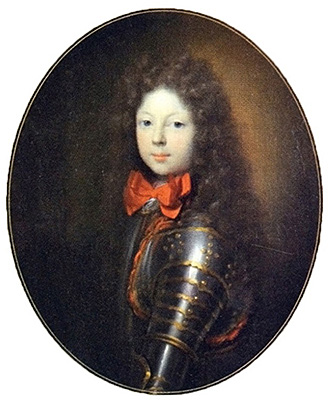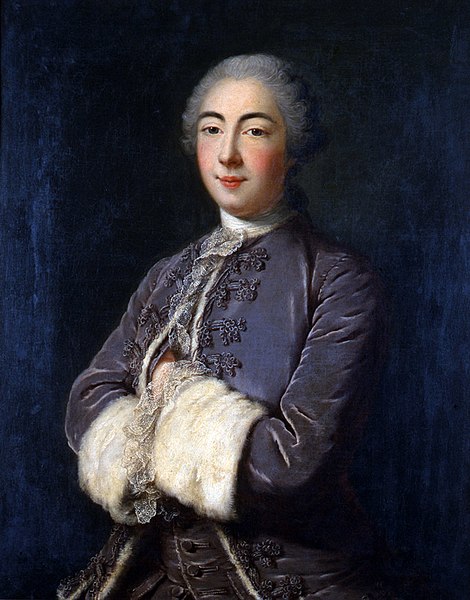Born on 16 January 1675, the young Louis de Rouvroy was born into very good circumstances. His father, Claude de Rouvroy, had been elevated to the rank of Duc de Saint-Simon in 1635 and had enjoyed the benefits of being a favourite of Louis XIII. The new mother was Charlotte de l'Aubespine was of an old, distinguished family but that was far from her best quality.
As it happened, Louis would benefit enormously from his mother. She was very intelligent and undertook her son's education personally while maintaining a good relationship with the elite of the French court. For instance, the chosen god-parents for the young boy were none other than Louis XIV and Marie-Thérèse. Consequently, Louis spent a large portion of his early childhood with his formidable mother - meanwhile his father, who was 68 years old at the time of his birth, would have taken the more traditionally, aloof approach to the infant.
Thus, the young boy grew into a young man who became more and more aware of his dues as a duke of France. At the age of 22, Louis entered the grey musketeers and immediately went into service. In 1692 he participated in the Siege of Namur before fighting at Neerwinden.
While Louis was fighting elsewhere, a marriage was being prepared for him. By this time, Louis was a very eligible bachelor. His father had died in 1693 leaving him as Duc de Saint-Simon at the age of 18. Already at the age of 19, we see clearly the characteristic that has become almost synonymous with the new Duc de Saint-Simon: obsession with rank. Despite his young age, Louis was perfectly prepared to take legal action when the Duc de Luxembourg attempted to move his place up in the inner hierarchy between dukes. At this point in history, there was a pecking order within the dukedoms in which the highest ranking was the one whose dukedom had been created first. Luxembourg attempted to claim that he should be second - rather than eighteenth - which would push Saint-Simon (number 12) further down. As a result, Saint-Simon filed a formal protest.
 |
| The Duc de Saint-Simon in his youth |
The chosen bride was Marie-Gabrille de Durfort, the daughter of the Duc de Lorges. The two would marry in 1695. Interestingly, their relationship was remarkably well-suited. One would suspect that a young man with such a large sense of superiority would have little regard for his wife but the reverse proved to be the case. Their marriage would be a prime example of a marriage in the ancien regime; while it does not appear to have developed into downright love, they possessed a mutual respect for each other and worked together to further their interests.
Also, it was noted that she possessed the knack for curbing his most pompous thinking. To the outside world the two appeared to have a relationship built on respect, trust and a certain level of affection.
Meanwhile, Louis - now in his mid-twenties - was eager to demand his dues. Like most other young noblemen he hoped to gain his reputation through military service and he certainly believed that his rank entitled him to a higher military rank or other promotion. Sadly for him, Louis XIV apparently disagreed. In what can only be described as a pique of wounded pride, he would resign his commission as officer in 1702.
This move on his behalf was characteristic of the young Louis de Rouvroy whose pride in his rank and obsession with furthering himself was already well-known. However, he should have known that Louis XIV was not one to take such a tantrum lightly. The king did not see the resignation as a matter of slighted honour but rather as a refusal to carry out his duty. While he probably did not realise it at the time, this act almost cost Louis his entire career at court.
 |
| The young Louis at 16 |
One can only speculate how the Duc de Saint-Simon managed to survive the obvious displeasure of the Sun King - but he did. From then on, Louis would dedicate his life to the routine of Versailles and the never-ending quest for furthering his family's interests.
One of his key points of conjecture was the matter of the royal bastards. Louis XIV had done everything in his power for his illegitimate children much to the shock of the old aristocracy. Saint-Simon was amongst those who were outraged when the king first married his children to princes and princesses of the blood but even that was nothing compared to what was to come. In 1714 he king decreed that his now legitimised sons could indeed inherit the throne of France, if the legitimised branches died out. While the situation seemed far-fetched considering how many people were in line to throne before them, it was hardly impossible - after all, no less than three dauphins had died since 1710.
His open dislike of the king's favourite children combined with his meticulous insistence on every little thing due to a duke, made the king think very little of him. Still, he appears to have been able to please when he wanted to as the Duc de Saint-Simon was still a welcome guest with many of the leading men of his day. Meanwhile, Louis showed himself to lack a talent - or taste - for court politics which is rather ironic considering his intimate knowledge of the goings-on at court. Even when his good friend, Pontchartrain, was made chancellor, he did not take the opportunity to seek further benefits for himself or his family.
While Louis was scheming to keep the legitimised princes out of any influence, his family was growing. Marie-Gabrielle gave him three children: Charlotte (later Princesse de Chimay), Jacques Louis (Duc de Ruffec) and Armand-Jean.
The death of Louis XIV in 1715 must have come as a relief to the Duc de Saint-Simon whose life had increasingly reached a dead-end. He was still far from gaining any favour with the king which essentially stalled his entire career which had instead begun to focus on cultivating useful alliances at court. When Philippe d'Orléans was declared regent - and Louis XIV's legitimised sons were removed from the line of succession - things appeared to have been far brighter than they had for years.
For the first time in years, the Duc de Saint-Simon found himself with a new appointment: he was amongst those chosen for the regency council. However, if he had expected the regent to take any advice from him, he was sorely disappointed. Louis had his own political vision of a France ruled, not by an absolute king, but by a Council consisting of the leading peers. As such, he himself would have exerted a far greater influence than he ever actually had.
Yet he now had an in with the focus of power which he used to obtain the position of ambassador extraordinary to Spain in 1721. His mission was to arrange for the young Infanta Mariana Victoria to be engaged to Louis XV.
Louis appears to have relished his time in Spain. After all, he was entrusted with a delicate but highly important task and spent lavishly to impress his hosts. Even when he caught the dreaded smallpox, he does not appear to have been too dejected - perhaps being made a Grandee of Spain helped to ease the pain.
 |
| Louis - with his new title of Grandee of Spain |
Once back in France, Louis' career went from lukewarm to ice-cold. His prodigious expenditure while in Spain had further damaged his already shaky finances. Curiously, the otherwise ambitious man does not appear to have done anything about it. Rather than joining the race for any type of profitable benefit, he instead retired from any form of politics. Towards the latter part of his life, he would write his famous memoirs of his time at court.
It seems paradoxical that a man whose legacy is almost entirely in his extensive memoirs should have left so little knowledge of his later years. By 1743 Marie-Gabrielle died and she was followed by their eldest son, Jacques Louis, in 1746. Considering his relationship with his wife, Louis must have been heartbroken. Whether that contributed to his continued absence from any intrigues can only be guessed at.
What we do know is that his relationships with men of power - including Cardinal Dubois and the Orléans-family - cooled immensely over the years. Naturally, his memoirs leave no indication for the reason behind such a split.
 |
| Louis in 1728 at the age of 53 |
As his life came to an end, Louis appears to have been a deeply disappointed man. He had grown up with a solid sense of superiority, a superiority which he firmly believed entitled him to some greatness. Yet, he had not received any. Having first been thwarted in his military endeavours by Louis XIV, he was then brushed aside by Philippe d'Orléans who had no time for his political ideas. Even after his successful ambassadorship to Spain, he had no been granted any new office - instead he could only watch the debts pile up. When the Duc de Saint-Simon died on 2 March 1755, he died penniless and somewhat disillusioned.
Looking back on the famous memoirist what type of man was he? Naturally, he is most famous for his almost obsessive insistence on his dues as a duke but he does not appear to have been particularly ambitious. Despite being placed in a prime spot for advancement in the regency council he never made any particular efforts to gain more influence, benefits or even pensions. Haughty to a fault, he appears to have had almost an expectation of being granted such things due to his rank at court - when that failed to materialise, he completely resigned himself.





